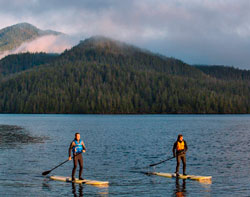Page Content
Stand-up Paddleboarding

The Stand Up Paddleboard or SUP has become quite popular thanks to its versatile and accessible design. The young and the young at heart can enjoy a quiet paddle on a SUP without having to worry about having to carry too much equipment or a large vessel. With inflatable SUPs available from many retailers, anyone can bring a SUP directly from the store to beach, with or without a car.
Aside from the more creative uses for the SUPs, such as yoga and fishing, SUPs are generally used in two ways:
- As an alternative to surfing, where a rider stands and uses a paddle to propel themselves through the water on the waves in light surf.
- As an alternative to canoeing or kayaking, called flat water paddling, where a rider paddles across calmer waters.
When SUPs are being used for flat water paddling, they are classified as a human powered vessel and users must follow specific regulations in order to keep themselves and others safe while on the water.
Required equipment:
- Personal floatation device.
- A sound-signaling device.
When SUPs are used within the surf zone for surfing activities, none of the above requirements are enforced.
In either use of SUP, the user does not require proof of competency.
Life Jacket and Personal Floatation Device (PFD)
As for all human powered vessels, there must be one Canadian approved life jacket or PFD available on your SUP, for immediate use. It is much easier to put on your life jacket or PFD on dry land than it is to put it on while in the water, so wearing it while paddling on your SUP is recommended.
Although Transport Canada supports the use of a leash, it does not recognize a leash/paddleboard combination as a floatation device.
For more information on human powered vessels and their requirements, please visit Transport Canada—Human Powered Craft.


